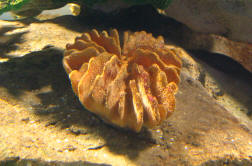|
Cnidaria (hydroids, sea fans, jellyfish, corals,
sea anemones)
Life
> Eukaryotes
>
Opisthokonta >
Metazoa
(animals)
Introduction
Cnidarians are bell-shaped or
tubular animals. The term cnidaria is derived from stinging cells, called
cnidocytes, present in this group. They have a, two layered, sac body
plan; the outer tissue layer is a protective epidermis and the inner
endoderm layer secretes digestive juices into the internal cavity called
the gastrovascular cavity. Two basic body forms are exhibited by
cnidarians during their lifecycle; a polyp has a mouth that is directed
upward whereas that of a jellyfish or medusa is directed downward. In some
cnidarians, one stage is dominant and the other is reduced or in other
species, one form may be absent altogether.
Having both muscles
fibres and nerve fibres, cnidarians are capable of directional movement by
either contracting or extending their bodies. Polyps usually stay in one
place (e.g. sea anemones) and medusae float or swim around in the water
column (e.g. jellyfish). Tentacles, forming a ring around the mouth, can
reach out and grasp prey that may
have been stung by the cnidocytes. Each cnidocyte houses a nematocyst that
contains a long, sometimes barbed, and spirally coiled hollow thread. When
a potential prey item touches the trigger of a cnidocyte, the nematocyst
is discharged and the thread either traps it or penetrates and paralyses
it with toxins. The gastrovascular cavity has a dual purpose in that food
items get digested there and it provides the animal with a hydrostatic
skeleton (using water pressure).
There are over 10,000 species of
cnidarians known globally which are placed within their classes based on the
lifecycle stages that are dominant within each. The Anthozoa are the most
primitive of the cnidarians and completely lack a medusoid "jellyfish"
stage in the life cycle, with a polyp stage persisting throughout. In the
class Hydrozoa the polyp stage is dominant and they may be solitary or
colonial. The Scyphozoa have a primary medusa stage and the polyp remains
small and insignificant. The Cubozoa are similiar to the Scyphozoa with
respect the their lifecycles. However, they are boxed shaped, possess four
evenly spaced out tentacles or bunches of tentacles and well-developed
eyes, and do not strobilate like true jellyfish do. At present ~842
Cnidarian species are known from South Africa.
   
Ecology
 Some cnidarians use their
cnidocytes to trap prey items. Jellyfish use their long cnidocyte laced
tentacles to capture and then feed on a variety of planktonic
invertebrates and are food themselves for other marine organisms like sea
turtles and sunfishes. The ability to ward off would be predators, using
stinging cells may also benefit other organisms, as is demonstrated by the
association of sting resistant clownfish with anemones. Other Anthozoans
depend on zooxanthellae, symbiotic dinoflagellates within the body walls,
to live. Corals are photosynthetic animals in a sense, in that the
dinoflagellates undergo photosynthesis and pass on the carbon compounds
that they produce to their hosts. Cnidarians may either be completely
dependant on zooxanthellae or use them to supplement their diets of
trapped food prey items. Corals living deeper than the photic zone (the
layer of water penetrated by sunlight) may not be dependant on symbionts
but colonial, reef-forming corals depend on them, thus, reefs can only
exist in shallow water. Some cnidarians use their
cnidocytes to trap prey items. Jellyfish use their long cnidocyte laced
tentacles to capture and then feed on a variety of planktonic
invertebrates and are food themselves for other marine organisms like sea
turtles and sunfishes. The ability to ward off would be predators, using
stinging cells may also benefit other organisms, as is demonstrated by the
association of sting resistant clownfish with anemones. Other Anthozoans
depend on zooxanthellae, symbiotic dinoflagellates within the body walls,
to live. Corals are photosynthetic animals in a sense, in that the
dinoflagellates undergo photosynthesis and pass on the carbon compounds
that they produce to their hosts. Cnidarians may either be completely
dependant on zooxanthellae or use them to supplement their diets of
trapped food prey items. Corals living deeper than the photic zone (the
layer of water penetrated by sunlight) may not be dependant on symbionts
but colonial, reef-forming corals depend on them, thus, reefs can only
exist in shallow water.
 |
 |
| |
|
Cnidaria and humans
Besides being fatally
stung by a box jellyfish or having our commercial fishing nets clogged by
jellyfish, cnidarians, especially Anthozoans, have considerable economic
importance. Many Cnidarians are the source of novel biomedical compounds
that have anti-carcinogenic (anti-cancer) properties. Corals provide
habitats for commercially fished organisms (eg., invertebrates, algae and
fish) while tempting tourists to spend their money in foreign countries,
which possess reefs for diving, snorkelling, boating and fishing. Corals
are traded in the aquarium and jewellery markets, while their aggregate
may even be mixed with concrete to be used in the building industry in
countries like the Maldives, Sri Lanka, India, Indonesia and Malaysia.
Many of these positives for humans
have, however, been to the detriment of these organisms. Human population
growth and urban development have contributed largely to habitat (reef)
destruction, over harvesting, increased pollution and increased
temperature. Coral bleaching occurs when masses of corals die due to
stress induce mortalities of their colourful photosynthetic symbionts,
which in turn is caused by the effects of global warming and the
destruction of the ozone layer. Destructive fishing using poison, like
cyanide, or dynamite is still practiced in some countries today and kill
off masses of reef as a consequence.
Classification
Text by Wayne K. Florence
|
